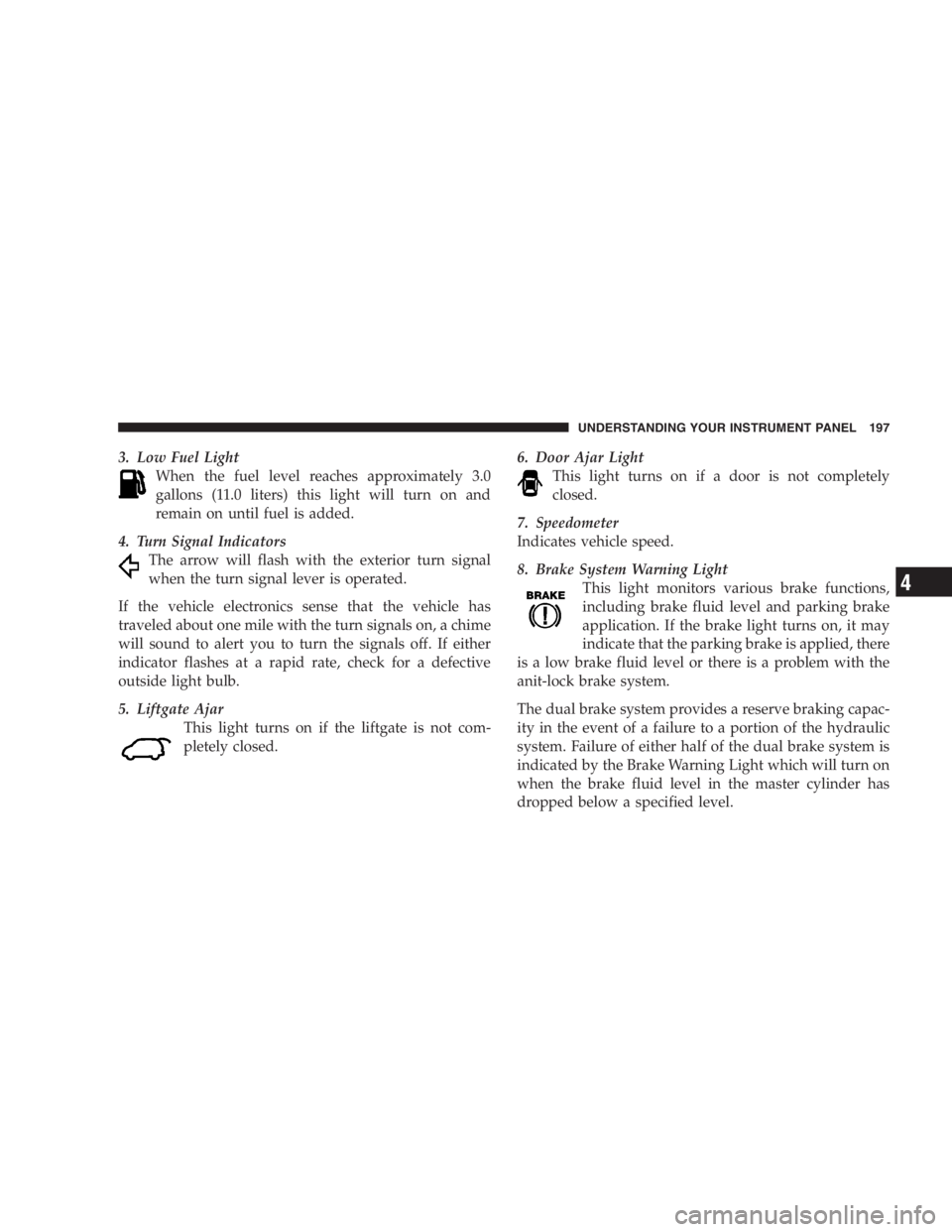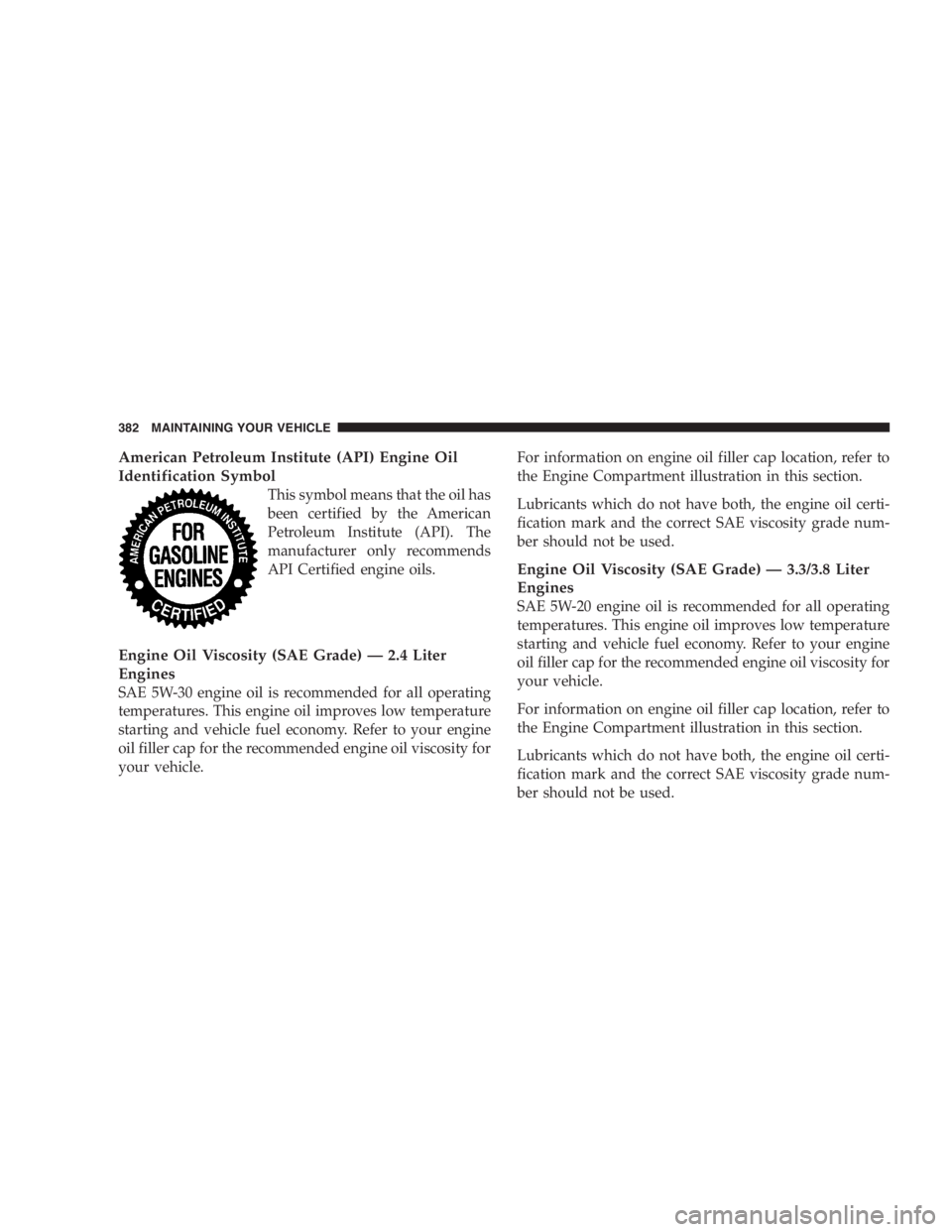Page 197 of 480

3. Low Fuel Light
When the fuel level reaches approximately 3.0
gallons (11.0 liters) this light will turn on and
remain on until fuel is added.
4. Turn Signal Indicators
The arrow will flash with the exterior turn signal
when the turn signal lever is operated.
If the vehicle electronics sense that the vehicle has
traveled about one mile with the turn signals on, a chime
will sound to alert you to turn the signals off. If either
indicator flashes at a rapid rate, check for a defective
outside light bulb.
5. Liftgate Ajar
This light turns on if the liftgate is not com-
pletely closed. 6. Door Ajar Light
This light turns on if a door is not completely
closed.
7. Speedometer
Indicates vehicle speed.
8. Brake System Warning Light
This light monitors various brake functions,
including brake fluid level and parking brake
application. If the brake light turns on, it may
indicate that the parking brake is applied, there
is a low brake fluid level or there is a problem with the
anit-lock brake system.
The dual brake system provides a reserve braking capac-
ity in the event of a failure to a portion of the hydraulic
system. Failure of either half of the dual brake system is
indicated by the Brake Warning Light which will turn on
when the brake fluid level in the master cylinder has
dropped below a specified level. UNDERSTANDING YOUR INSTRUMENT PANEL 197
4
Page 202 of 480

NOTE: You must apply the brakes before shifting from
Park.
19. Oil Pressure Warning Light
This light shows low engine oil pressure. The light
should turn on momentarily when the engine is
started. If the light turns on while driving, stop the
vehicle and shut off the engine as soon as possible. A
chime will sound for 4 minutes when this light turns on.
Do not operate the vehicle until the cause is corrected.
This light does not show how much oil is in the engine.
The engine oil level must be checked under the hood.
20. High Beam Light
This light shows that the headlights are on high
beam. Pull the turn signal lever towards the
steering wheel to switch the headlights from high or low
beam. 21. Malfunction Indicator Light
This light is part of an onboard diagnostic system
called OBD that monitors engine and automatic
transmission control systems. The light will illu-
minate when the key is in the ON position before engine
start. If the bulb does not come when turning the key
from OFF to ON, have the condition checked promptly.
Certain conditions such as a loose or missing gas cap,
poor fuel quality, etc. may illuminate the light after
engine start. The vehicle should be serviced if the light
stays on through several of your typical driving cycles. In
most situations the vehicle will drive normally and will
not require towing.
The Malfunction Indicator Light flashes to alert to serious
conditions that could lead to immediate loss of power or
severe catalytic converter damage. The vehicle should be
serviced as soon as possible if this occurs.202 UNDERSTANDING YOUR INSTRUMENT PANEL
Page 291 of 480
� Adding Fuel ..........................334
▫ Fuel Filler Cap (Gas Cap) ...............334
� Vehicle Loading ........................336
▫ Vehicle Certification Label ...............336
▫ Gross Vehicle Weight Rating (GVWR) .......336 ▫ Gross Axle Weight Rating (GAWR) .........336
▫ Overloading .........................337
▫ Loading ............................337
� Trailer Towing .........................338
▫ Towing Requirements ..................339 STARTING AND OPERATING 291
5
Page 334 of 480
ADDING FUEL
Fuel Filler Cap (Gas Cap)
The gas cap is behind the fuel filler door on the left side
of the vehicle. If the gas cap is lost or damaged, be sure
the replacement cap is for use with this vehicle. CAUTION!Damage to the fuel system or emission control
system could result from using an improper fuel
tank filler tube cap (gas cap). A poorly fitting cap
could let impurities into the fuel system.
NOTE: The driver ’ s side sliding door cannot be opened
while the fuel door is open. This feature operates only
when the sliding door is fully closed prior to opening the
fuel door.
CAUTION!To avoid fuel spillage and overfilling, do not “ top
off ” the fuel tank after filling has stopped.Fuel Filler Cap (Gas Cap)334 STARTING AND OPERATING
Page 335 of 480
NOTE:
• Tighten the gas cap until you hear a “ clicking ” sound.
This is an indication that the gas cap is properly
tightened. If the gas cap is not secured properly the
Malfunction Indicator Light will turn on. Make sure
that the gas cap is tightened each time the vehicle is
refueled.
• When the fuel nozzle “ clicks ” or shuts off, the fuel
tank is full. WARNING!• Never have any smoking materials lit in or near
the vehicle when the gas cap is removed or the
tank filled.
• Never add fuel to the vehicle when the engine is
running.
• A fire may result if gasoline is pumped into a
portable container that is inside of a vehicle. You
could be burned. Always place gas containers on
the ground while filling. STARTING AND OPERATING 335
5
Page 382 of 480

American Petroleum Institute (API) Engine Oil
Identification Symbol
This symbol means that the oil has
been certified by the American
Petroleum Institute (API). The
manufacturer only recommends
API Certified engine oils.
Engine Oil Viscosity (SAE Grade) — 2.4 Liter
Engines
SAE 5W-30 engine oil is recommended for all operating
temperatures. This engine oil improves low temperature
starting and vehicle fuel economy. Refer to your engine
oil filler cap for the recommended engine oil viscosity for
your vehicle. For information on engine oil filler cap location, refer to
the Engine Compartment illustration in this section.
Lubricants which do not have both, the engine oil certi-
fication mark and the correct SAE viscosity grade num-
ber should not be used.
Engine Oil Viscosity (SAE Grade) — 3.3/3.8 Liter
Engines
SAE 5W-20 engine oil is recommended for all operating
temperatures. This engine oil improves low temperature
starting and vehicle fuel economy. Refer to your engine
oil filler cap for the recommended engine oil viscosity for
your vehicle.
For information on engine oil filler cap location, refer to
the Engine Compartment illustration in this section.
Lubricants which do not have both, the engine oil certi-
fication mark and the correct SAE viscosity grade num-
ber should not be used.382 MAINTAINING YOUR VEHICLE
Page 421 of 480
License Light
1. Remove the two lens assembly mounting screws. 2. Pull the bulb out of the socket. Replace the bulb and
reattach the lens assembly.
FLUIDS AND CAPACITIES
U.S. Metric
Fuel (Approximate) 87
Octane 20 Gallons 76 Liters
Engine Oil-with filter
2.4 Liter Engines (SAE 5W-30, API Certified) 5.0 qts 4.7 Liters
3.3 & 3.8 Liter Engines (SAE 5W-20, API Certified) 5.0 qts 4.7 Liters
Cooling System *
2.4 Liter Engines (Mopar � Antifreeze/Coolant 5 Year/100,000
Mile Formula) 11.4 qts 10.7 Liters
3.3 & 3.8 Liter Engines (Mopar � Antifreeze/Coolant 5 Year/
100,000 Mile Formula) † 13.4 qts 12.6 Liters
* Includes heater and coolant recovery bottle filled to MAX level.
† * Add 2.9 quarts (2.8 liters) if equipped with a rear heater. MAINTAINING YOUR VEHICLE 421
7
Page 422 of 480
RECOMMENDED FLUIDS, LUBRICANTS AND GENUINE PARTS
Engine
Component Fluids, Lubricants and Genuine Parts
Engine Coolant Mopar � Antifreeze/Coolant 5 Year/100,000 Mile Formula HOAT (Hybrid Or-
ganic Additive Technology)
2.4 Liter Engine Oil Use API Certified SAE 5W-30 engine oil. Refer to your oil filler cap for cor-
rect SAE grade, meeting DaimlerChrysler Material Standard MS-6395.
3.3/3.8 Liter Engine Oil Use API Certified SAE 5W-20 engine oil. Refer to your oil filler cap for cor-
rect SAE grade, meeting DaimlerChrysler Material Standard MS-6395.
Oil Filter 2.4 liter engines Mopar 4105409 or equiv.
Oil Filter 3.3/3.8 liter engines Mopar 5281090 or equiv.
Spark Plugs Refer to the Vehicle Emission Control Information label in the engine com-
partment.
Fuel Selection 87 Octane422 MAINTAINING YOUR VEHICLE